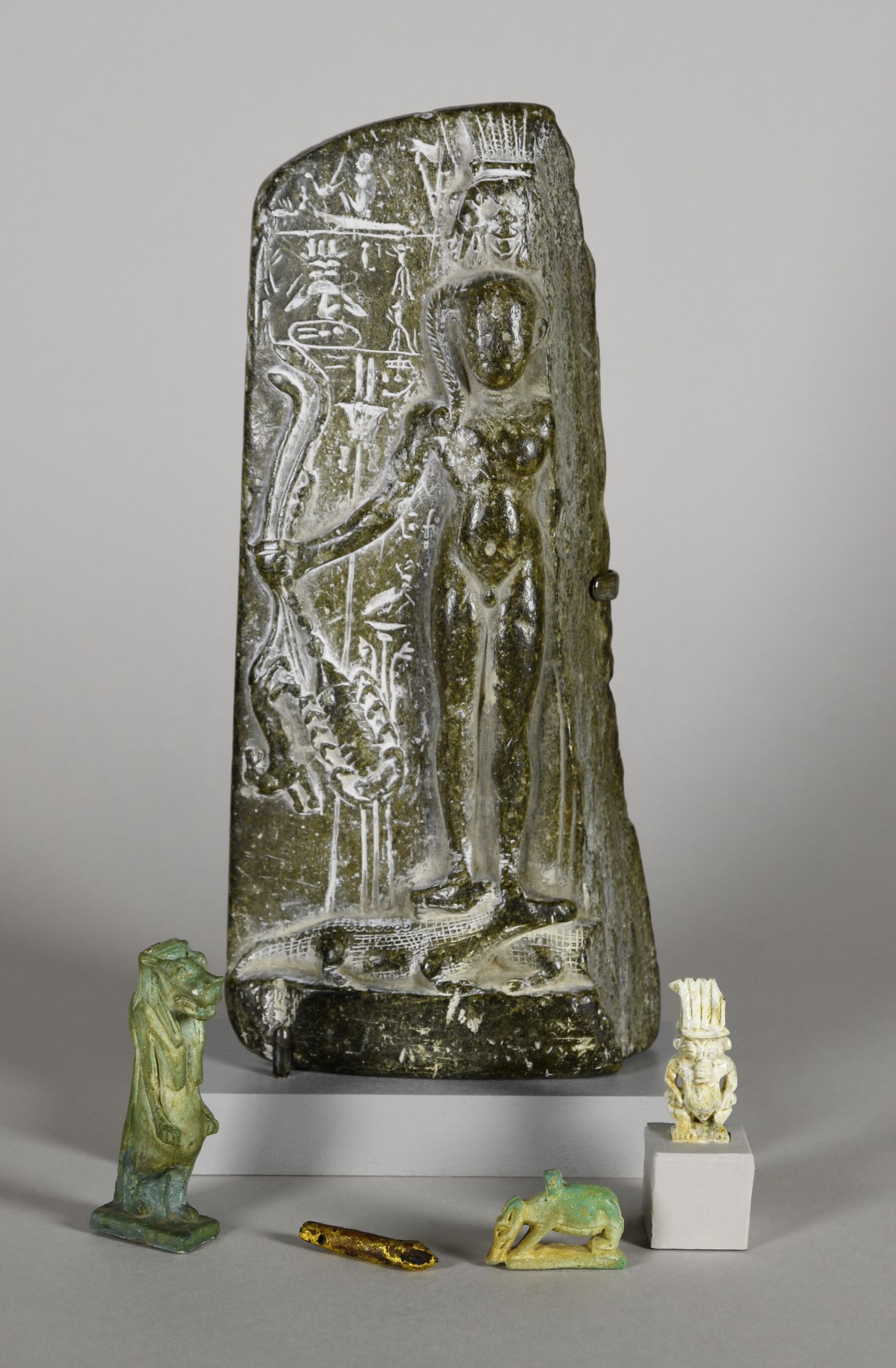The ancient Egyptians believed the cippus protected the owner or bearer from animal bites and provided magical healing. Cippi were worn or carried by the owner while traveling on the Nile or in the desert.1 Cippi were also set up in temple healing shrines. Water poured over the stela’s images, and magical texts absorbed their power. The liquid was then dispensed to supplicants and the afflicted.2
This fragmentary cippus depicts Horus as a naked child wearing a sidelock. On his right is a standard with lotus and double plumes. Horus holds a scorpion and a lion by their tails and two snakes, all dangerous. Below, he tramples two crocodiles to control their malevolence. Bes, the deity who protected the family and home oversees the containment of these evil forces. The cippus’s front, back, and sides are covered with religious and magical texts to imbue the stela with power. This cippus dates to the 26th to 30th Dynasties based on its style and paleography.3
The cippus is made of peridotite, a rock from the earth’s upper mantle brought up from depth by deep magma. When peridotite encounters seawater, chemical reactions create magnetic minerals. Ptolemaic accounts mention the use of magnets to attract iron elements.4 Whether the magnetic properties of peridotite led to its use as a magical stone is unclear. Peridotite is found in Egypt’s Eastern Desert.5
Ancient Egyptians wore protective amulets to ward off evil forces. Amulets of household deities such as Bes and Taweret safeguarded women and children and were particularly helpful during childbirth. Amulets of female pigs endowed their wearer with fertility. Snake and snakehead amulets were worn to guard against poisonous snake bites.
MH
-
Draycott, Jane. 2011. “Size matters: Reconsidering Horus on the crocodiles in miniature.” Pallas 86: 123–133.. ↩︎
-
Ritner, Robert K. 2008. The Mechanics of Ancient Egyptian Magical Practice. SAOC 54. Chicago: The Oriental Institute of the University of Chicago.. ↩︎
-
Sternberg-el Hotabi, Heike. 1999. Untersuchungen zur Überlieferungsgeschichte der Horusstelen: Ein Beitrag zur Religionsgeschichte Ägyptens im 1. Jahrtausend v. Chr. ÄA 62. Wiesbaden: Harrossowitz.. ↩︎
-
Lowe, Dunstan. 2016. “Suspending Disbelief,” Classical Antiquity 35, no. 2 (October): 247-278.. ↩︎
-
Abdel-Rahman A. M., El-Desoky H. M., Shalaby B. N. A., Awad H. A., Ene Antoaneta, Heikal M. A., El-Awny H., Fahmy W., Taalab S. A., Zakaly Hesham M. H. 2022. “Ultramafic Rocks and Their Alteration Products From Northwestern Allaqi Province, Southeastern Desert, Egypt: Petrology, Mineralogy, and Geochemistry.” Frontiers in Earth Science 10. https://www.frontiersin.org/articles/10.3389/feart.2022.894582. ↩︎
Bibliography
- Abdel-Rahman et al. 2022
- Abdel-Rahman A. M., El-Desoky H. M., Shalaby B. N. A., Awad H. A., Ene Antoaneta, Heikal M. A., El-Awny H., Fahmy W., Taalab S. A., Zakaly Hesham M. H. 2022. “Ultramafic Rocks and Their Alteration Products From Northwestern Allaqi Province, Southeastern Desert, Egypt: Petrology, Mineralogy, and Geochemistry.” Frontiers in Earth Science 10. https://www.frontiersin.org/articles/10.3389/feart.2022.894582
- Draycott 2011
- Draycott, Jane. 2011. “Size matters: Reconsidering Horus on the crocodiles in miniature.” Pallas 86: 123–133.
- Lowe 2016
- Lowe, Dunstan. 2016. “Suspending Disbelief,” Classical Antiquity 35, no. 2 (October): 247-278.
- Ritner 2008
- Ritner, Robert K. 2008. The Mechanics of Ancient Egyptian Magical Practice. SAOC 54. Chicago: The Oriental Institute of the University of Chicago.
- Sternberg-el Hotabi 1999
- Sternberg-el Hotabi, Heike. 1999. Untersuchungen zur Überlieferungsgeschichte der Horusstelen: Ein Beitrag zur Religionsgeschichte Ägyptens im 1. Jahrtausend v. Chr. ÄA 62. Wiesbaden: Harrossowitz.
